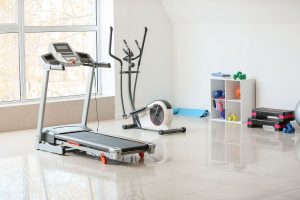
With the increasing popularity of home workouts, people often find themselves deliberating between different exercise equipment options. Two of the most common machines are treadmills and elliptical trainers.
Both offer excellent cardiovascular workouts, but they differ in design, functionality, impact on joints, muscle engagement, and more. In this article, we will explore the differences between treadmills and elliptical machines to help you make an informed decision about which one is best suited for
your fitness goals.
Table of Contents
Definition of Treadmill
A treadmill is a stationary exercise machine that features a moving belt on which users can walk, jog, or run in place. It allows users to simulate outdoor walking or running indoors. Treadmills come with adjustable speed and incline settings, providing versatility in workouts. They often include features such as heart rate monitors, pre-programmed workout routines, and even interactive screens for added entertainment.
Definition of Elliptical
An elliptical machine, also known as an elliptical trainer or cross-trainer, is another popular exercise device. It mimics movements similar to walking, running, or climbing stairs, but with reduced impact on the joints. An elliptical machine features pedals and handles that users can hold onto while performing a fluid, elliptical motion. Some models also offer the option to pedal in reverse, targeting different muscle groups.
Design and Functionality
Treadmills and elliptical machines have different designs and functionalities. Treadmills consist of a motorized belt that moves under your feet, allowing you to walk, jog, or run. You control the speed and incline levels to adjust the intensity of your workout. On the other hand, elliptical machines have two foot pedals and handlebars. As you step on the pedals and hold onto the handles, you create an elliptical motion, engaging both your upper and lower body muscles simultaneously.
Cardiovascular Benefits
Both treadmills and elliptical machines provide excellent cardiovascular benefits. They elevate your heart rate, improving cardiovascular endurance treadmills and strengthening your heart. Regular use of either machine can help reduce the risk of heart disease, lower blood pressure, and increase lung capacity. The choice between the two ultimately depends on your personal preference and the impact you want on your joints.
Impact on Joints
One of the significant differences between treadmills and elliptical machines is the impact they have on joints. Treadmills offer a higher impact workout as the user’s feet strike the moving belt with each step. This impact can be beneficial for bone health and improving bone density. However, for individuals with joint issues or those seeking a low-impact workout, an elliptical machine is a better choice. The elliptical motion reduces stress on the joints, making it an ideal option for those with joint pain or injuries.
Muscles Targeted
Treadmills primarily target the lower body muscles, including the quadriceps, hamstrings, calves, and glutes. While the upper body is engaged to some extent for balance and support, the focus remains on lower body strength and endurance. In contrast, elliptical machines offer a full-body workout. The pushing and pulling motion of the handles engages the muscles of the arms, shoulders, chest, and back, in addition to the lower body muscles. If you’re looking for a more comprehensive workout that involves both upper and lower body muscle groups, an elliptical machine is an excellent choice.
Calorie Burning
Both treadmills and elliptical machines are effective calorie-burning tools. The number of calories burned depends on various factors such as intensity, duration, and individual characteristics. Generally, treadmills tend to burn more calories per hour compared to elliptical machines, primarily because they engage more lower body muscles. However, the difference may not be significant enough to be the sole deciding factor in choosing one machine over the other.
Workout Variety
Treadmills offer a wide range of workout options. You can walk, jog, or run at different speeds and incline levels. Many treadmills also provide pre-programmed workout routines, including interval training, hill workouts, and customizable options. Elliptical machines, although limited to a single motion, often feature adjustable resistance levels. Some models also allow you to pedal in reverse, introducing additional variety to your workouts. Both machines offer the flexibility to customize your workouts based on your fitness level and goals.
Accessibility
When it comes to accessibility, treadmills are relatively straightforward to use. Walking and running are natural movements that most individuals are already familiar with, making it easier to adapt to a treadmill workout. On the other hand, elliptical machines may require a slight learning curve, especially for those who have never used them before. The elliptical motion and coordination between the upper and lower body take some practice to master. However, with consistent use, users can quickly become comfortable and efficient on an elliptical machine.
Cost
The cost of treadmills and elliptical machines can vary significantly based on brand, features, and quality. Generally, treadmills tend to be more expensive than ellipticals due to their additional components like motors and larger running surfaces. However, it’s essential to consider the long-term investment in your fitness goals rather than solely focusing on the upfront cost. Assess your budget and choose a machine that provides the features and durability you need for long-term use.
Space Requirements
When considering exercise equipment for home use, space availability is crucial. Treadmills typically occupy more floor space due to their larger size and the requirement for a running belt. Elliptical machines, on the other hand, have a more compact footprint. Some models even come with foldable options, making storage more convenient. Evaluate the space you have available and choose a machine that fits well without causing clutter or obstruction.
Comparison and Contrast
To summarize the differences between treadmills and elliptical machines:
- Treadmills feature a moving belt for walking, jogging, or running, while elliptical machines offer a fluid, elliptical motion.
- Treadmills have a higher impact on joints, making them more suitable for individuals seeking a weight-bearing workout, whereas elliptical machines provide a low-impact option.
- Treadmills primarily target lower body muscles, while elliptical machines engage both upper and lower body muscles simultaneously.
- Treadmills tend to burn more calories per hour, but the difference may not be significant enough to be the sole deciding factor.
- Treadmills offer a wider variety of workout options, including speed and incline adjustments, while elliptical machines focus on resistance levels and sometimes reverse pedaling.
- Treadmills are generally more accessible for beginners, while elliptical machines may require a learning curve.
- Treadmills are usually more expensive than elliptical machines, but long-term investment and durability should be considered.
- Treadmills require more space compared to elliptical machines, although foldable options are available for both.





